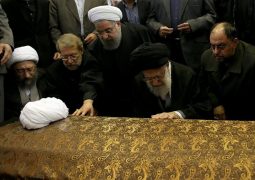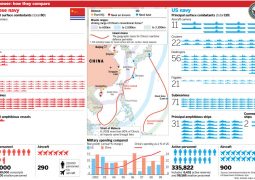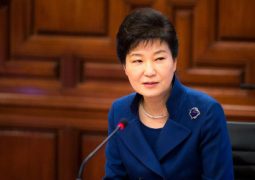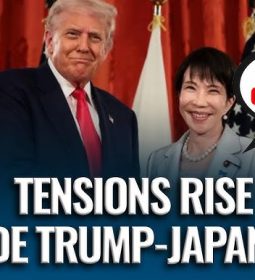North Korea Fires Four Ballistic Missiles Into Waters Off Coast, South Korea Says

SEOUL—North Korea fired four ballistic missiles into the waters off its east coast Monday morning, South Korea’s Joint Chiefs of Staff said, the latest sign of Pyongyang’s determination to push ahead with its missile program despite increasing pressure against it.
The Joint Chiefs said the projectiles were launched from Tongchang-ri in North Korea’s northwestern North Pyongan Province, at 7:36 a.m. Seoul time on Monday. North Korea has a launch site for longer-range rockets northwest of the capital Pyongyang.
They said the projectiles flew about 620 miles and that the South Korean authorities were analyzing exactly what type of projectiles were fired. There were no immediate signs of any damage.

A Japanese government spokesman on Monday said North Korea launched four missiles, and that three had landed inside Japan’s Exclusive Economic Zone, an area extending about 230 miles out to sea from its coastline.
South Korea’s acting president, Prime Minister Hwang Kyo-ahn, convened a meeting of the Standing Committee of the National Security Council in response on Monday morning. Japan’s Prime Minister Shinzo Abe said he would hold a meeting of its National Security Council to discuss the missile launches.
South Korea’s national-security adviser, Kim Kwan-jin, also spoke by phone with his U.S. counterpart, Lt. Gen. H.R. McMaster, a spokesman for the South Korean president’s office said. During the meeting, Mr. Hwang called the missile launch “an act of outright defiance to the international community, and a serious provocation.”
The U.S. State Department condemned the launches on Sunday night, while reaffirming its commitment to defending allies including south Korea and Japan.
“The [Democratic People’s Republic of Korea]’s provocations only serve to increase the international community’s resolve to counter the DPRK’s prohibited weapons of mass destruction programs,” said Mark Toner, acting State Department spokesman.
South Korea’s semiofficial Yonhap News Agency reported that the projectiles may have included an intercontinental ballistic missile, citing an unnamed official at the defense ministry.
An ICBM test would signal dramatic progress by the North toward being able to threaten the continental U.S. It would also likely ratchet up tensions among North Korea, its neighbors and the U.S.
South Korea’s Joint Chiefs of Staff said there is “a low probability” that North Korea may have tested an ICBM. A South Korean defense ministry official said the flight paths of four projectiles—including the flight distance and the maximum height of about 160 miles—indicate they weren’t ICBMs.
“The North American Aerospace Defense Command (NORAD) determined the missile launch from North Korea did not pose a threat to North America,” said Cmdr. Gary Ross, a Pentagon spokesman.
In his New Year address in January, North Korea leader Kim Jong Un warned that the country was completing preparations for a test launch of an ICBM.
A day later, U.S. President Donald Trump tweeted in response: “It won’t happen!” Mr. Trump didn’t elaborate.
The White House is undergoing a policy review on North Korea, and is considering a wide range of options, including diplomacy and possible military action to force regime change.
The North has yet to test an ICBM, though in 2006, it fired a missile that was later used as a space launcher.
As with its launch in February, which came while Mr. Trump was meeting with Mr. Abe in West Palm Beach, Fla., analysts and experts struggled to identify details of the exact launch. In that case, analysts initially identified the missile as an intermediate-range missile it had previously fired.
But the missile was actually a modified version of a submarine-launched missile that Pyongyang called the Polaris-2, boasting new capabilities that some experts hadn’t yet expected North Korea to have developed.
‘North Korea is getting very good at switching up their tests. They keep changing the variables analysts watch for, so it is harder to quickly assess what any one event was.’
In this case, South Korea’s Joint Chiefs initially identified one missile launch from Tongchang-ri site, but then modified their assessment to include three more missiles, though it remains unclear whether those missiles were also fired from the same site.
“This is an unusual launch because of its number and location. If it was this number in a different location or just one launch from this location, it would make sense,” said Scott LaFoy, a satellite-imagery and ballistic-missile analyst based in Washington. “North Korea is getting very good at switching up their tests. They keep changing the variables analysts watch for, so it is harder to quickly assess what any one event was.”
The North’s missile launch took place as the U.S. and South Korea were conducting annual joint military exercises, strongly opposed by Pyongyang. The North regularly rails against the military drills in its state media, saying the drills are preparations for a possible invasion of the country—allegations the U.S. and South Korea dismiss.
Jeffrey Lewis, an arms-control expert at the California-based Middlebury Institute of International Studies, said that it was normal for the North launch a salvo of missiles during big U.S. exercises, to signal that they can “practice nuking the forces we are practicing with to invade them.”
He added that “they are conveying that their plan, early on, is to use nuclear-armed missiles at our forces in the region to repel an attack.”
The launch also comes as North Korea faces diplomatic challenges from friendly countries like China, which said in February that it would cut off coal imports from North Korea in line with international sanctions efforts against Pyongyang, as well as Malaysia, which ordered the expulsion of North Korea’s ambassador over the weekend.
In the case of Malaysia, the decision to expel the North Korean ambassador, Kang Chol, came weeks after the daylight killing of Kim Jong Nam, the half brother of Kim Jong Un, in Kuala Lumpur International Airport, which South Korean intelligence has described as an assassination ordered by Pyongyang. Malaysian authorities said the killing involved the use of VX, a deadly nerve agent that is one of the world’s most lethal chemicals.
South Korea’s Foreign Ministry on Monday lashed out at the North for launching more missiles “while the international community is shocked and angry about North Korea’s inhuman killing of Kim Jong Nam using chemical weapon VX.”
The ministry said the launch “clearly reveals North Korea’s ruthlessness in continuing to develop its nuclear and missile programs, disregarding the unified warnings of the international community.”
—Alastair Gale in Tokyo contributed to this article.
Write to Jonathan Cheng at jonathan.cheng@wsj.com and Kwanwoo Jun at kwanwoo.jun@wsj.com
- Previous Closed Afghan-Pakistani Border Is Becoming ‘Humanitarian Crisis’ By MUJIB MASHALMARCH 5, 2017
- Next Using VX to Kill Kim Jong-nam ‘Unacceptable,’ Malaysia Leader Says
















